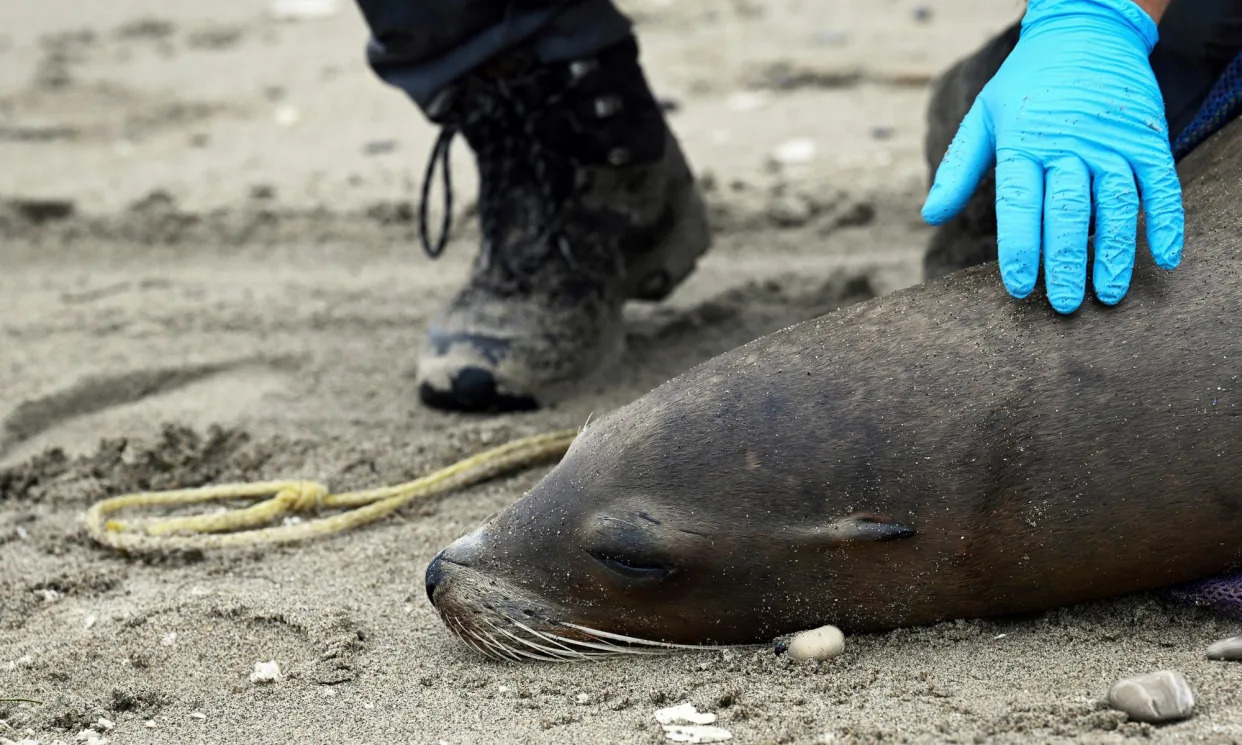Sick sea lions stranded on California coast as experts fear algae poisoning
Abené Clayton and agencies
Fri, 2 August 2024

A beached sea lion exhibiting signs of domoic acid poisoning.Photograph: Olga Houtsma/AP
Sea lions are stranding themselves on a long stretch of the California coast in what experts say could be a sign of widespread poisoning by a harmful algae bloom this summer.
The Channel Islands Marine & Wildlife Institute (Cimwi) said that since 26 July, it had been inundated by daily reports of sick sea lions along the shoreline in Santa Barbara and Ventura counties.
The marine mammals are suffering from domoic acid, a neurotoxin that affects the brain and heart, the institute said in a statement. The poisoning event is largely affecting adult female California sea lions, it said.
Samuel Dover, the co-founder and executive director of the non-profit, said that his team of 150 people – mostly volunteers – were in the first week of domoic acid season and had rescued 23 animals so far. Coastal Vandenberg space force base released photos of sea lions being rescued from one of its beaches this week.
“In a typical no-domoic-acid-day, you may get 2-3 calls, but during domoic acid, you’re getting 100 calls,” said Dover, who is also a veterinarian. “We’re kind of getting used to it – not in a good way, mind you – but we know where to utilize our resources without stretching ourselves too thin.”
On Friday, Cimwi received over 100 calls and performed 20 rescues. But even with these interventions, more than half of the sea lions the group encountered died before they can get treatment or make it back into the water.
“It’s depressing,” Dover adds. “You go out there knowing what you can and cannot do because you have an animal having an active seizure and its chance of survival is slim to none.”
Staff with the group have been responding to calls along the 155 miles of coastline the group covers, Cimwi said in a press release.
“Rising ocean temperatures and excess nutrients are fueling these blooms, producing toxins that enter the food chain through small fish,” Vandenberg space force said in an Instagram caption that accompanied photos of a stranded sea lion being treated by wildlife officials.
“Local efforts, including monitoring and rescue initiatives, are in place to mitigate the impact.”
Outbreaks of domoic acid poisoning are common along the California coast and have caused several mass sickening events in recent years. The neurotoxin is produced by a microscopic alga that works its way up the food chain by accumulating in smaller marine animals, such as crustaceans, fish and squid, and then gets transferred to larger animals such as sea lions, dolphins and birds. People can also get sickened.
The symptoms for affected animals can include disorientation, head weaving, foaming at the mouth and seizures. Some sea lions get through the worst of domoic acid poisoning in one to three days and return to the water on their own, according to CIMWI. Those who need further care are taken to a rehabilitative facility where they are given treatments like anti-seizure medication and fed fish that do not carry the toxin.
Last June saw an especially severe outbreak, with marine mammal rescue workers receiving dozens of calls a day about sickened animals.
While such events are naturally occurring, scientists have said that domoic acid outbreaks seems to be increasing in their severity, and are exploring the links to warming ocean temperatures.
“I’ve been studying domoic acid for 30 years and I have a feeling it’s getting worse based on the records we continue to break,” the executive director of the Southern California Coastal Ocean Observing System, Clarissa Anderson, told the Guardian in an interview last year.
“Last year had the highest recorded levels of domoic acid in animal tissue we’ve ever seen.”
As these outbreaks increase in frequency from every two to three years to becoming an annual occurrence, Dover wants to see more municipalities put money behind groups such as Cimwi who work to keep the beaches safe from sick sea lions and work to get the animals the help they need.
“These animals are tripping, I guarantee you,” Dover said. “This is a public safety issue and there are a lot of times we feel like we’re not getting resources.”
No comments:
Post a Comment